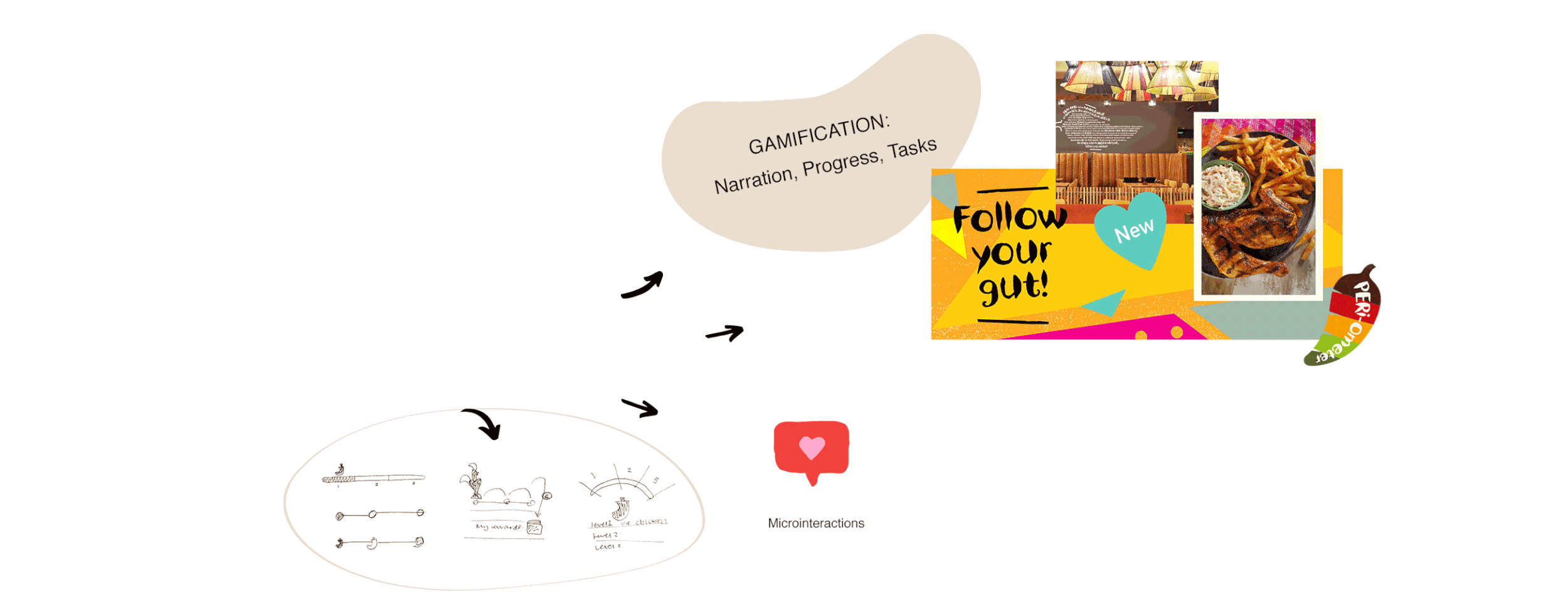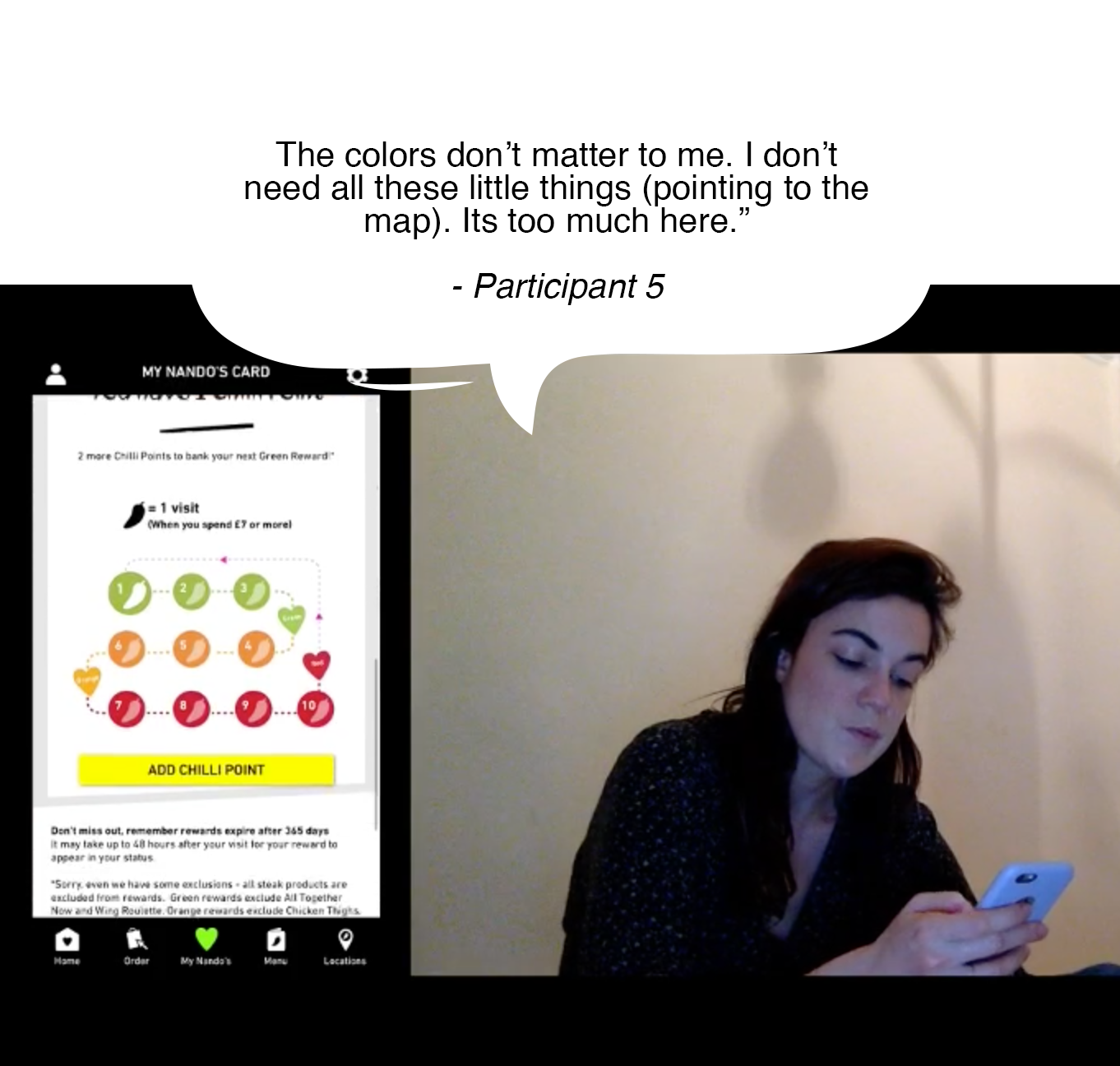
Nando’s Loyalty Program Redesign
Can emotional design impact customer retention and engagement?
My Role: UX/UI Designer
The Project: Develop a media specialist practice (Emotional Design) and apply it towards a new or existing problem to create an efficient solution.
This was a student project for Kingston University and was not sponsored by Nando's UK & IRE.Background
Why Nando’s?
I am currently working as a UX Design Intern on the Digital Marketing team at Nando's HQ. While an existing brief, the team has not yet started the project, allowing me to apply my take complete ownership.
Why the Loyalty Program?
Loyalty programs are proven to be one of the most effective ways to increase customer retention and loyalty. In addition to costing less to acquire than new customers, return customers are also more likely to spend more with a company.
Why emotional design?
Emotions play a key role in creating meaningful customer relationships. By looking at the current Loyalty Program design through an emotional lens there is large opportunity to reduce customer feelings of confusion and in turn, impact their behavior.
Aims & Objectives
Current App Experience
Aim:
Create a more enjoyable, trustworthy, and clear UX of the Nando's Loyalty Program by redesigning it's current visual explanation on the mobile app.
Objectives:
Conduct User Interviews to understand customer feelings and comprehension of the current program and it's description on the app.
Analyse "best-in-class" competitors and literature to define the most important emotions needed in a successful loyalty program and how these are expressed through design.
Research psychology theories and cognitive processes to understand how humans perceive emotions and feelings of motivation.
Outline the Loyalty Program customer journey across all different touch points, both online and offline to contextualize pain points
Redesign the current Rewards page of the app to create a more enjoyable, trustworthy, and clear experience for users
User Test and iterate mockups at different levels of fidelity to understand remaining user confusion and research questions

The Current Experience
User tests were administered in-person using OBS Software to film both the user’s emotions and their screen behavior.
Screenshot taken from user test session.5 in-person Interviews were conducted to identify user pain points and feelings towards the current experience.
Participants:
All participants lived in the UK
4 out of 5 participants were Nando’s customers
None of the participants have the Nando’s App
2 out of 5 participants are a part of the Nando’s Loyalty Program
Age range was between 21 to 29
Key Findings:
0 participants had a clear understanding of how the program works. Main points of confusion included:
Do you start back at zero after redeeming your reward?
What is the difference and meaning of green, orange, and red?
The map visual felt overly complicated and added confusion
Participant's described their initial feelings toward the loyalty page as: confusing, overwhelming, busy, unnecessarily complicated
3 Participants mentioned the look and feel of the app is not representative of the experience they have walking into the restaurant
Literature Review
Loyalty Programs impact customer behavior.
84% of consumers say they’re more likely to stick with a brand that offers a loyalty program - 66% of them say the ability to earn rewards actually changes their spending behavior.
(Peacock, 2018)Human motivation is driven by 3 basic needs.
Self-Determination Theory states that fulfilling the 3 basic human psychological needs (Autonomy, competence, and relatedness) facilitates self-growth and motivation.
(Designing for Motivation: Three Theories eLearning Designers Can Use, 2020)Customer longevity with brands is linked to emotion.
The 3 main emotions customers desire in their long-term relationships with brands are: joy, trust and belonging.
(Burkard, 2019)Gamification can increase long-term engagement.
Gamification can increase long term engagement and clarity of goals through narration, progress and tasks.
(Kärpuk, 2017)
Sketching and Ideation
Goals:
Reduce feelings of confusion and complication
Bring in the warmth, fun, and excitement of the Nando's brand
Add elements of Joy, Trust, and Belonging
Increase feelings of motivation
Process:
Crazy 8s Exercise
Lit Review Sketching
UI Ideation
Lo-Fi Designs
Goal: Reduce feelings of confusion and provide a clear understanding of how the program works.
Research Questions:
Is it clear how many chilli's they have?
Do they know how many more they need to get a reward?
Do they understand what reward they are working towards?
What is their understanding of the locked items?
Once a chilli point is added, is the progression clear?
Once they redeem the first reward, do they think they start back to zero? Or continue on?
Testing and Iterations
Two user tests were completed to evaluate user understanding of the lo-fi designs. Results were based on one participant who had seen the previous Nando’s experience, and one who had not. This decision was made in order to gain insight on potential bias and ensure returning customers were not put off by the unfamiliar experience.
Key Findings:
Both participants had clear understanding of their current rewards status and what they had to achieve in order to gain a reward
Both participants were able to successfully add a Chilli Point to their account
Both participants were familiar with the unlock concept and understood how they would function
The participant without previous knowledge of the program assumed that rewards would be kept without starting over but was not 100% clear.
“I would assume you keep going, but I can definitely see how that would provide confusion.” - Participant 2
Hi-Fi Designs and Final Prototype
Goals:
Solve for remaining confusion around whether or not you start back at 0 after redeeming a reward
Add color/brand elements to increase feelings of joy and excitement
Micro-Interactions:
To elicit additional feelings of joy, a sample hi-fi animation was created to explore micro-interactions. This video would be used in user testing as a low risk way to asses its success before development.
Animations made using Adobe After Effects
Next Steps
In a real-world context, a second round of user testing would be completed during this phase to evaluate the success of the hi-fi designs vs. the original experience. Using a comparative test method, participants would be shown both experiences and asked to complete a series of tasks. In addition, a post-test questionnaire would be administered to gather self-reported metrics on emotional response and feelings towards the experience.
References
Burkard, K., 2019. Which Emotions Are The Key To Successful Customer Relationships. [online] smile.io. Available at: <https://learn.smile.io/blog/which-emotions-are-the-key-to-successful-customer-relationships> [Accessed February 2020].
Kärpuk, K., 2017. How To Gamify A Loyalty Program. [online] ART & Marketing. Available at: <https://artplusmarketing.com/how-to-gamify-a-loyalty-program-b8cde1044523> [Accessed March 2020].
Peacock, L., 2018. 10 Examples Of Innovative Customer Loyalty Programs. [online] Shopify Blog. Available at: <https://www.shopify.com/blog/loyalty-program> [Accessed February 2020].
Shiftelearning.com. 2020. Designing For Motivation: Three Theories Elearning Designers Can Use. [online] Available at: <https://www.shiftelearning.com/blog/bid/340354/designing-for-motivation-three-theories-elearning-designers-can-use> [Accessed February 2020].











